Australia So Much to See


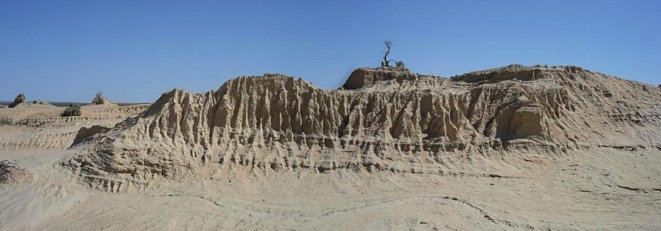
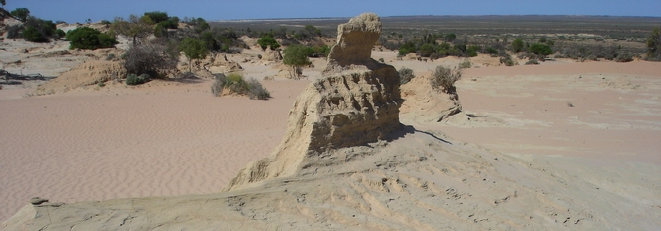
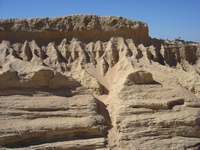
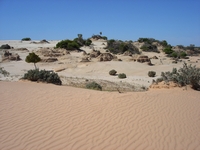
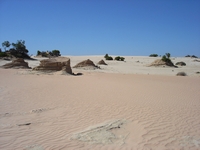
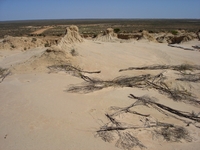
The birth of civilisation? In just one National Park you can visit where
History of Mungo
The mystery and aura of this ancient land is sensational. This relatively small area hid mega fauna fossils
deposited in the lakes, bones of the earliest known Australian inhabitants were discovered in the crescent shaped sand dune known
as a lunette, and from ancient fire beds a previously unknown geomagnetic excursion (magnetic pole reversal) was revealed, and all
these discoveries were made in our lifetime.
It is here in the lunette that remains of Mungo man and Mungo woman were
found. There is evidence that these bodies were buried with some form of ceremony, making
While previous DNA testing did not find a link between Mungo Man and today's Aborigines, recent DNA testing results, released for publication in May 2016, have revealed these previous tests were erroneous, bridging the gap culturally and now physically between the ancient occupants of Mungo and the Aboriginal race.
A huge white topped crescent shaped sand dune crosses the park, and as it erodes down, ancient sand and clay sculptures, like the
sandcastles made by dripping wet sand, are being uncovered by the winds. Layers of different colours show different ages of
sand; red, yellow and grey. The pink Gol Gol sands at the base of the lunette were laid down between 120,000 and 100,000 years
ago during a dry period. The yellow look of the brownish cream and white sands of the upper and lower Mungo layers are between
60,000 and 37,000 years old and were formed when the lakes were full. The Arumpo/Zanci grey clays which cap the pinnacles were formed
37,000 to 18,000 years ago, during an era when the lakes filled and dried out several times. The white dune crests have
been formed since the lakes finally dried out 14,000 years ago. Most of the Aboriginal artefacts were discovered in the brownish-cream
and grey layers. The dune is moving eastward at the rapid rate of about three metres per year.
Aboriginal artefacts discovered show the Aborigines have inhabited the area for at least the past 40,000 to 45,000 years. These
artefacts include 10,000 year old sandstone grinders which were used for grinding seeds, showing that these people were amongst the
first in the world to grind flour. The stone used was not local and came from at least 100 kilometres away.
In 2003, footprints preserved in the clay of the lakes and covered with sand were revealed. These have been dated at between
19,000 and 23,000 year old, and are the largest area of Pleistocene human footprints in the world. Castings of the footprints
were taken to tell the story at The Meeting Place (the new Visitor Centre), before covering these tracks with sand to keep them preserved. 457 footprints have been found, belonging to adults and children, generally walking in single file. Prints are between thirteen
and thirty centimeters in length. The latter is the equivalent of a modern size eleven shoe, and indicated a man of
around two metres tall. One set of tracks has been calculated to have been made by someone running at twenty kilometres per hour. Much speculation has taken place over a set of right foot only prints. Was there a one legged man? Was he hopping or using
a stick? Maybe there was shallow water and one foot was in a boat or some type of floatation devise. Examination of the
prints indicated he was hopping very fast and keeping up with the others in his group, showing skill at hopping as a long term thing
rather than a short term injury or aided by a walking stick.
The region has seen wet and dry periods. With lush growth in times long past of plentiful rain, the semi arid area is now generally
dry.
Over the past 200 years, the area has been grazed as pastoral stations, and remains of station outbuildings and dams to stock water
can be seen when taking the loop drive around the park. Much on the denuding of vegetation on the lunette is attributed to the
grazing station livestock; however it was the subsequent erosion that led to the amazing discoveries hidden in the lunette. Vigar’s
Well was once a coach stop, and drays crossed the lunette here. Now, with no vegetation to hold the sands, even walking to the
top was slow going, and imagining a horse drawn dray crossing these sands was something to marvel at.
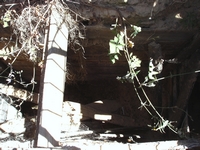
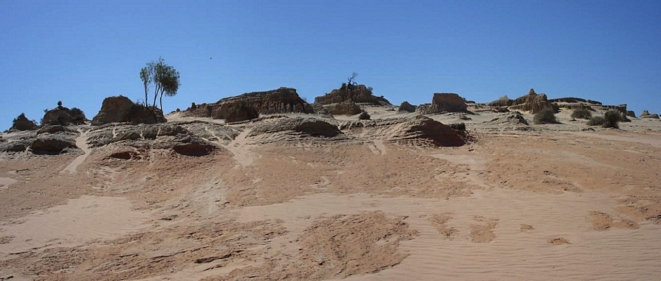
Mungo National Park - the birth of civilisation
Since the closure of freely walking on the lunette, the only way to experience this is on a Ranger guided walk. You will also be shown artefacts otherwise inaccessible to visitors. Fees apply in addition to park entry fees. Adult $50 per person. Concession/Pensioners $35 per person (price current May 2021). Walks are conducted most days an as requested basis and can be booked on line from National Parks NSW. See times and availability when booking.